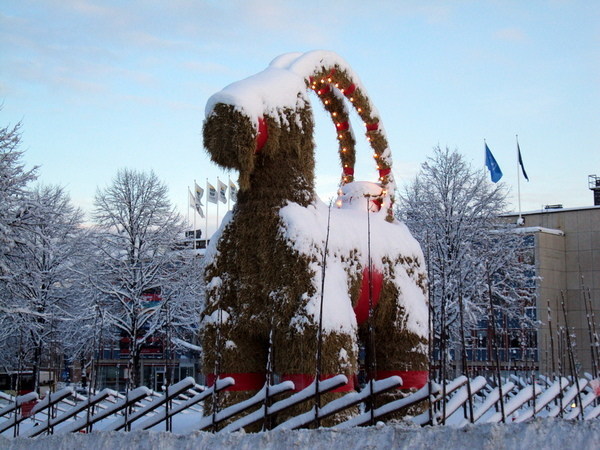December 25 is a big day at my house and lots of others: enjoying time with family or friends, maybe sharing a big meal or some festive sweets, decorating trees, singing carols… or waking up early to see what gifts the kids have received from Joulupukki.
Oh, you mean you’re not from Finland?
Well, there are Christmas gift-givers all over the world.
Many of them will look pretty familiar to those of us in the US who know about Santa Claus, but a few aren’t, or weren’t.
Let’s start with Joulupukki, whose name in Finnish means “Yule goat.”
The goat was a Pagan symbol that was adapted into Christmas traditions in Finland and across Scandinavia.
There’s a town in neighboring Sweden that puts up a giant straw goat each year (and most years it gets burned down!?!)
The Yule goat was originally more of a trickster character, something like the Krampus.
Its job was to find naughty kids and either play pranks on them or just flat-out scare them.
Over time the “goat causing mayhem” gimmick has given way to a friendly character who spreads cheer and gives gifts.
In fact, while the Joulupukki name has stuck around, today it looks more like a human with a long white beard and a red suit.
Now where have I heard that before?
Some places have gift giving traditions that are centered on the Christkind, the baby Christ, or on the Three Kings from the Nativity story.
A few have a Santa Claus-like figure who gives gifts on Christmas Eve or Christmas Day, and then other characters pop by at different times during the holidays.
In Italy, the man with the bag is known as Babbo Natale, but La Befana can also see them when they’re sleeping and knows when they’re awake.
She’s more or less an old witch who flies around on a broomstick giving out gifts on Epiphany Day in early January.
By the way, some people in Norway have a tradition of hiding their brooms at Christmas just in case a witch drops by.
In Liberia, in west Africa, there’s a character known as Old Man Bayka.
He walks from house to house during the holidays asking people to give him presents, usually for some kind of charitable cause.
In the region of Galicia in northwestern Spain, there’s a traditional character known as the Apalpador, who has a long red beard, a pipe and a beret.
He pops by at New Year’s to poke at kids’ bellies to make sure they’ve been eating and then to share a present or two.
And, finally, we have there’s a Catalonian tradition of filling a Tio de Nadal, a Christmas log with a face and legs that you fill with different delicacies.
Then, when Christmas comes, they hit it with sticks, piñata-style, and the treats come out the back end.
These are known as caga tió, which translates to (please forgive me) “pooping logs.”
Something new to add to the holiday schedule next year?
However you’re spending this holiday, whatever traditions you may or may not be part of, here’s hoping you have a very Merry Christmas.
Around the world, kids’ Christmas gifts include KFC, books and ‘pooping logs’ (CNN)
Christmas gift-bringers of Europe (JakubMarian.com)

